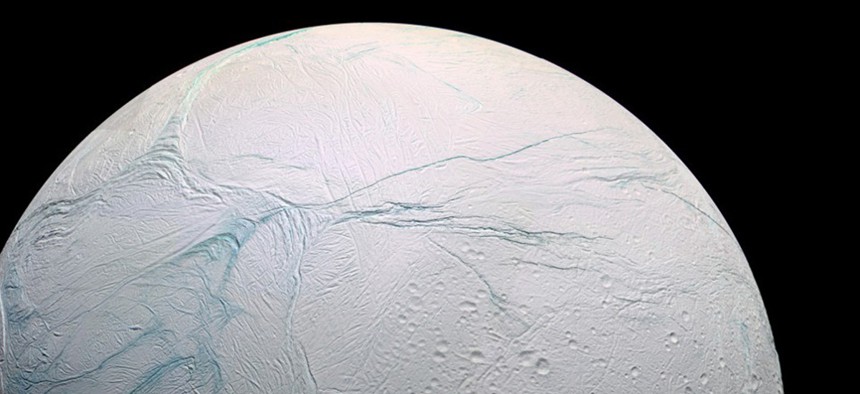NASA Looks to Explore the Oceans of the Outer Solar System
A new generation of probes will look for signs of life in the liquid plumes that shoot out from Jupiter and Saturn’s moons.
The oceans offered humanity’s first passage beyond the boundaries of the known world. Ships brought people to unfamiliar shores on voyages of discovery, often just because they could. Today, the oceans of other worlds are the edges of our unknown. In the next decade, scientists will dispatch an armada of ships to these oceans, in hopes of discovering entirely new forms of life.
In the past few years, planetary scientists have learned that some of the moons around the solar system’s biggest planets are full of water. Europa, one of Jupiter’s moons, is thought to have an ocean of liquid water beneath its icy crust. A few million miles away, Saturn’s satellite Enceladus has a water ocean, too. Its sister moon, Titan, has lakes and oceans made of liquid methane. All these moons also have energy sources and hydrocarbons, long thought to be the ingredients for life. If a spacecraft could somehow sample the water, it might be able to look for signs of something living in it.
Luckily for us, both Europa and Enceladus are spitting their water out into space. Enceladus spews so much water, it’s creating an extra icy ring around Saturn. Europa is ejecting much less, but still enough for scientists to see plumes of water shooting out from its surface with the Hubble Space Telescope. Spacecraft could fly through these plumes and take a tiny sip, tasting for the presence of telltale molecules. Think of scooping up ash from the atmosphere above an erupting volcano. It wouldn’t be easy, but it would be a lot simpler than trying to land a rover, boat, submarine, or some other kind of probe.
NASA is planning to visit Europa in the late 2020s, with a flyby mission informally called the Europa Clipper. But the spacecraft will have a hard time looking for direct evidence of life, in part because the environment around Europa is horrible. “I’ve been jokingly criticized for calling it evil,” says Peter Spidaliere of NASA’s Goddard Space Flight Center. “It’s the worst place in the solar system for radiation.” Blame Jupiter, whose titanic magnetic field traps and speeds up particles. Jovian radiation would zap any spacecraft instruments that aren’t hidden behind special shields—making it harder to taste misty, ephemeral clouds of water vapor. And it may be difficult for a lander or rover to find much on Europa’s surface, because Jupiter’s radiation belts would rip apart the biological molecules. So instead, Spidaliere and his colleagues propose a small companion spacecraft to the main Europa Clipper, which they’re calling the Bee (Biosignature Explorer for Europa).
The Bee, about half the size of an adult human, would fly at the Clipper’s side all the way to Europa, where it would launch from the mother ship. It would fly through a fresh plume, using a suite of instruments to inspect its contents. The spacecraft would then make a quick exit and perform its analysis far from the radiation belts.
“We are trying to capture a sample before it’s had a chance to be destroyed by radiation,” Spidaliere says.
There is one problem: Scientists have only seen plumes on Europa once before, using Hubble. It’s not clear that they really exist, let alone persist all the time. To date, no one has located the plume again, and some scientists have argued that Hubble actually saw plasma from the volcanic moon Io. But Spidaliere and Amato say they have run simulations based on Hubble’s evidence, and they’re confident the plumes are real and will last long enough for a quick taste in a few years.
Enceladus is a different story. That moon definitely has plumes, and they’re spewing water, water everywhere all the time. Shannon MacKenzie wants to go catch it, with a new Enceladus mission called Theo, for Testing the Habitability of Enceladus’s Ocean. Mackenzie and her fellow graduate students have designed Theo to carry five chemistry instruments that could capture large biological molecules in the plumes.
The Cassini Saturn orbiter has flown by Enceladus two dozen times in the past decade, and the plumes are one of the mission’s most prominent discoveries. But Cassini is going too fast to detect large biological molecules and other potential life clues, which would be smashed in Cassini’s collectors like so many insects on a windshield. It’s not clear how dense the plumes are, or just what they contain, MacKenzie says. “There’s still a lot that we don’t know, which is why we need to go back,” she says.
The instruments on Bee and Theo wouldn’t be able to detect little green microbes directly, however. It would be more like looking for fingerprints. Higher abundances of certain molecules, ratios of organic compounds, or chains of amino acids could all give away life.
Neither of these concepts is a sure thing yet. The researchers shared their ideas this week at a planetary science conference in Houston, which focused heavily on Earth’s moon, Mars and Pluto, the celestial body of the hour. Still, while Mars still gets most of the planetary science attention — and money — the case has been building for a few years that icy moons could be even better places to look for life. Funding for the Europa mission was announced with great fanfare last spring, and the stunning images from the New Horizons mission to Pluto only bolster the argument for venturing to the outer solar system. After all, gigantic oceans are more tantalizing than dry Martian riverbeds. In the years to come, those oceans may offer us passage into the strangest realm humans have ever traversed, one in which we finally learn we are not alone.



